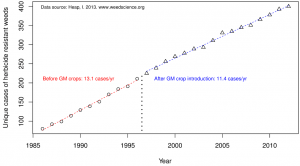What Is a Superweed?
go.ncsu.edu/readext?396666
en Español / em Português
El inglés es el idioma de control de esta página. En la medida en que haya algún conflicto entre la traducción al inglés y la traducción, el inglés prevalece.
Al hacer clic en el enlace de traducción se activa un servicio de traducción gratuito para convertir la página al español. Al igual que con cualquier traducción por Internet, la conversión no es sensible al contexto y puede que no traduzca el texto en su significado original. NC State Extension no garantiza la exactitud del texto traducido. Por favor, tenga en cuenta que algunas aplicaciones y/o servicios pueden no funcionar como se espera cuando se traducen.
Português
Inglês é o idioma de controle desta página. Na medida que haja algum conflito entre o texto original em Inglês e a tradução, o Inglês prevalece.
Ao clicar no link de tradução, um serviço gratuito de tradução será ativado para converter a página para o Português. Como em qualquer tradução pela internet, a conversão não é sensivel ao contexto e pode não ocorrer a tradução para o significado orginal. O serviço de Extensão da Carolina do Norte (NC State Extension) não garante a exatidão do texto traduzido. Por favor, observe que algumas funções ou serviços podem não funcionar como esperado após a tradução.
English
English is the controlling language of this page. To the extent there is any conflict between the English text and the translation, English controls.
Clicking on the translation link activates a free translation service to convert the page to Spanish. As with any Internet translation, the conversion is not context-sensitive and may not translate the text to its original meaning. NC State Extension does not guarantee the accuracy of the translated text. Please note that some applications and/or services may not function as expected when translated.
Collapse ▲Superweed is a a relatively recent term that is generally not used by weed scientists or other agricultural scientists. Superweed was coined to reflect what weed scientist call weed resistance. I made a video about superweeds that can watch here. Andrew Kniss, a professor at the University of Wyoming wrote a good blog called Where are the Superweeds?
The chart below is from Dr. Kniss’s blog. This chart shows that resistant weeds (superweeds) existed prior to the introduction of biotech crops and after the introduction. Notice that the rate of new cases of weed resistance (superweeds) increased more rapidly before the introduction of crop biotechnology. Weed resistance (superweeds) like resistance to antibiotics, fungicides or insecticides, is due to overuse of a herbicide, not biotechnology. Farming systems that rely on the same pesticides used over and over will likely lead to resistance, whether or not they involve biotechnology. Alternating herbicide modes of action from year and/or including additional modes of action within a season can reduce the likelihood of herbicide resistance.
Keith Edmisten, Professor of Crop Science



